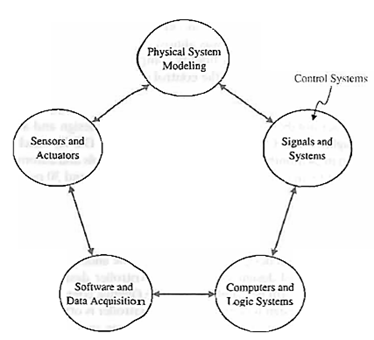Mechatronic Systems
MECHATRONIC SYSTEMS

Fig: 1 The key elements of mechatronics
A natural stage in the evolutionary process of modern engineering design is encompassed in the area known as mechatronics. The term mechatronics was coined in Japan in the 1970s. Mechatronics is the synergistic integration of mechanical, electrical, and computer systems and has evolved over the past 30 years, leading to a new breed of intelligent products. Feedback control is an integral aspect of modern mechatronic systems. One can understand the extent that mechatronics reaches into various disciplines by considering the components that make up mechatronics. The key elements of mechatronics are
(1) Physical systems modeling,
(2) Sensors and actuators,
(3) Signals and systems,
(4) Computers and logic systems, and
(5) Software and data acquisition.
Feedback control encompasses aspects of all five key elements of mechatronics, but is associated primarily with the element of signals and systems, as illustrated in Figure 1. Advances in computer hardware and software technology coupled with the desire to increase the performance-to cost ratio has revolutionized engineering design. New products are being developed at the intersection of traditional disciplines of engineering, computer science, and the natural sciences.
Advancements in traditional disciplines are fueling the growth of mechatronics systems by providing "enabling technologies." A critical enabling technology was the microprocessor which has had a profound effect on the design of consumer products. We should expect continued advancements in cost-effective microprocessors and microcontrollers, novel sensors and actuators enabled by advancements in applications of micro-electromechanical systems (MEMS), advanced control methodologies and real-time programming methods, networking and wireless technologies, and mature computer-aided engineering (CAE) technologies for advanced system modeling, virtual prototyping, and testing. The continued rapid development in these areas will only accelerate the pace of smart (that is, actively controlled) products.
An exciting area of future mechatronic system development in which control systems will play a significant role is the area of alternative energy production and consumption. Hybrid fuel automobiles and efficient wind power generation are two examples of systems that can benefit from mechatronic design methods. In fact, the mechatronic design philosophy can be effectively illustrated by the example of the evolution of the modern automobile. Before the 1960s, the radio was the only significant electronic device in an automobile. Today, many automobiles have 30-60 microcontrollers, up to 100 electric motors, about 200 pounds of wiring, a multitude of sensors, and thousands of lines of software code. A modern automobile can no longer be classified as a strictly mechanical machine—it has been transformed into a comprehensive mechatronic system.